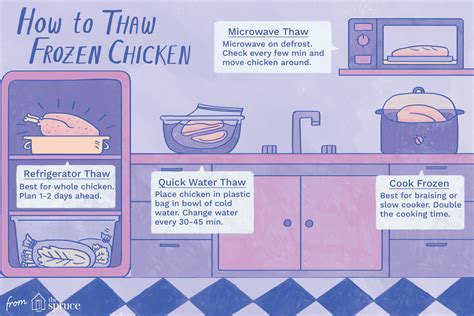How to Quickly Thaw Chicken: Safe and Efficient Methods
Thawing chicken safely and efficiently is crucial for food safety and meal preparation speed. Improper thawing can lead to bacterial growth, causing foodborne illnesses. This guide explores several quick and safe methods to thaw your chicken, ensuring both convenience and safety.
Understanding the Risks of Improper Thawing
Before diving into the methods, it's crucial to understand the dangers of improper thawing. Leaving chicken at room temperature for extended periods allows harmful bacteria like Salmonella and Campylobacter to multiply rapidly. This significantly increases the risk of food poisoning. Never thaw chicken at room temperature.
The Fastest Ways to Thaw Chicken
Here are some of the quickest and safest methods to thaw your chicken:
1. Cold Water Thawing: The Speedy Soak
This method is remarkably efficient. Place the chicken in a leak-proof plastic bag. Submerge the bag in cold water, ensuring the water completely covers the chicken. Change the water every 30 minutes to maintain a consistently cold temperature. A one-pound package of chicken can thaw in about 30 minutes using this method. Larger packages will take proportionally longer. This is a significantly faster alternative to refrigerator thawing.
2. Microwave Thawing: Quickest Method (with Caution)
Microwave thawing is the fastest option, but requires careful attention. Place the chicken on a microwave-safe plate and thaw on the defrost setting. Monitor closely to prevent uneven thawing and cooking. Cook the chicken immediately after thawing. Uneven thawing can lead to parts of the chicken remaining frozen while others begin to cook, increasing the risk of bacterial growth.
3. Refrigerator Thawing: The Safest, but Slowest Method
While slower, refrigerator thawing is the safest method. Place the chicken in a sealed container or bag on a plate (to catch any drips) on the bottom shelf of your refrigerator. Allow ample time; a whole chicken may require 24 hours or more to thaw completely. Plan ahead! This method guarantees consistent, slow thawing, minimizing the risk of bacterial growth.
Tips for Safe Chicken Thawing
- Always check the internal temperature: Use a food thermometer to ensure the chicken reaches a safe internal temperature of 165°F (74°C) before consuming.
- Never refreeze thawed chicken: Once thawed, cook the chicken immediately. Refreezing increases the risk of bacterial growth and compromises food safety.
- Thoroughly wash your hands: Wash your hands thoroughly with soap and water before and after handling raw chicken. Clean all surfaces that have come into contact with raw chicken.
- Cook thoroughly: Ensure the chicken is cooked to the proper internal temperature to eliminate harmful bacteria.
- Use separate cutting boards: Use separate cutting boards for raw chicken and other foods to prevent cross-contamination.
Choosing the Right Thawing Method for You
The best method depends on your time constraints and priorities. For speed, cold water thawing or microwave thawing are excellent choices (with caution for the microwave method). For guaranteed safety and convenience, refrigerator thawing is the best bet, even if it requires more planning. Always prioritize food safety above speed. Remember, a safe meal is always the best meal.
